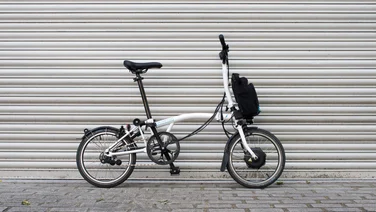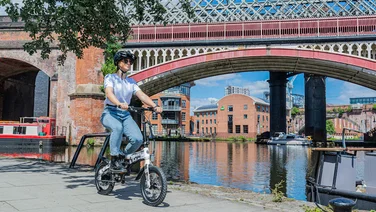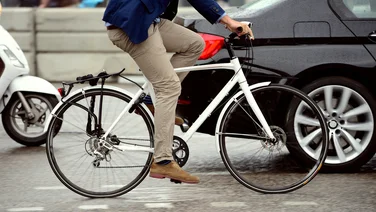To help us provide you with free impartial advice, we may earn a commission if you buy through links on our site. Learn more













- Elegant, effective folding mechanism
- Simple yet smooth pedal assistance
- Responsive and stable ride at high speed
- Could do with more advanced features
- Very expensive
- Heavier than the regular Brompton
Save an impressive 20% on the Brompton Electric
As you can read just below, we found the Brompton Electric to be a joy to ride, with smooth pedal assistance and good stability, as well as enjoying its elegant design and portability. One thing we did quibble over, however, was its price. With 20% lopped off that number as part of Pure Electrics' Mid-Season Sale, we're happy to renew and redouble our praise for this bike, with its new price making it a highly tempting choice once again. Snag this quality e-bike at a vastly reduced price for a limited time only.
£2308
Pure Electric
For good or bad, most electric bikes look very much like e-bikes. You can spot them a mile off with their big blocky batteries and motors surrounding the bottom bracket or wheel-based hub motors.
Brompton’s first foray into the world of electromotive bicycles, however, is a little bit different. At first glance, it looks pretty much identical to a regular Brompton. You can see the motor if you know what you’re looking for. It’s in the big, chunky hub at the centre of the front wheel. But where’s the battery? Where’s the display?
Brompton Electric review: What you need to know
Now look again. The battery and its charger are in the bag mounted on the block at the front of the bike. There’s no display on the handlebars, but you do get a series of status LEDs built into the panel at the top of the battery.
Otherwise, this is a Brompton just like any other. The frame is solidly built with robust steel tubes and the folding system is the most elegant and efficient around. To do that, simply pull the clip between the rear frame triangle and seat post, then swing the rear wheel under the frame. Next, unscrew the top-tube clamp and fold the bike in half before undoing the stem clamp to fold the handlebars down against the front wheel. Slide down the seat tube to lock the whole lot together and you’re done.













All folded, the Brompton Electric is just as ridiculously compact as its non-powered siblings. It will fit in most car boots and is small enough to stow under your desk at work.
The big difference is that the powered front hub adds extra weight over the regular Brompton. In total, the Electric weighs 13.7kg without the battery clipped to the front (for the two-speed model) and 16.6kg with the battery mounted, while the normal Brompton starts at 11.1kg. Although the motor means it’s easier to pedal the bike from A to B, the Brompton Electric requires a bit more brawn when it comes to lugging it from road to railway platform and back again.
READ NEXT: The best e-bikes to buy from £850
Brompton Electric review: Price and competition
The Brompton Electric is also a lot more expensive than the company’s regular folding bikes. And when I say a lot, I mean A LOT. While the two-speed, non-electric Brompton starts at £745, the Electric is £2,695 for the basic build. That includes the battery, charger and the bag and bracket that clips on the front. It’s worth noting you can upgrade to a larger, 20-litre version of this bag, but it’s a pricey extra and will set you back £130.
If that looks too pricey for you, there are alternatives. For those who like the Brompton design, it’s possible to buy a regular Brompton and turn it into an e-bike yourself with a simple aftermarket kit. Nano Electric Bikes offer DIY kits such as this from £750 and Swytch Bike has two Brompton kits for sale for £799 (25-mile range) or £899 (50-mile range). That’s still not cheap but it works out a lot less than Brompton’s, admittedly more elegant, in-house setup.













As for other manufacturers, there are some contenders, but none that fold up as small as the Brompton. At the budget end of the market, you have Decathlon with its B’twin Tilt 500, costing a bargain £650, and the Volt Metro from £1,399.
If you have more money to spend, GoCycle is the obvious rival and a veteran in the e-bike scene. Its latest GX model costs at £2,899. Hummingbird claims its electric folder is the lightest on the market but for that privilege you’ll also be paying a lot (£4,495). The Brompton Electric doesn’t look so pricey now, does it?
Key features, the ride and performance
As with all street-legal e-bikes sold in the UK, the Brompton Electric is a pedal-assist model – a “pedelec”, if you will. Push the pedals and, assuming you’ve charged the battery and mounted it to the front, the bike’s 250W hub motor will add some extra power until your speed reaches 15.5mph, the maximum speed UK law on e-bikes allows for. There’s no throttle, as UK law currently prohibits those, but you don’t really need one.
The Brompton Electric offers three levels of power assist, which are selectable by pressing a button on top of the battery. I preferred to use the maximum level of assist, which gives a pleasant surge of acceleration and is strong enough that you’ll not be putting much effort in up the hills. Using maximum assist does limit how long the 36V, 8.55Ah battery lasts, though.
With a quoted range of between 20 to 45 miles, it will be fine for most journeys and it’s a claim I found to be pretty accurate. During my 11-mile commute, the LED capacity indicator on top of the battery would normally drop just below halfway by the time I got home, requiring a recharge before riding the same distance again.













If you want to cycle further than 20 miles in one charge, you’ll have to scale back the level of assistance but even if the battery runs out, the bike is light enough that it doesn’t feel sluggish to pedal without power.
It rides well, too, and I found the extra weight doesn’t impact negatively on handling in the slightest. If anything, it makes the steering feel more predictable. And anyone who’s ridden a Brompton before won’t be surprised to discover that the Electric version is pretty stable at speed, too. Despite its small 16in wheels, at 15.5mph or just above, the Brompton Electric flies along – but you’ll need to be a little more wary of potholes given the small size of those wheels.













With pedal assistance engaged, the Brompton delivers a smooth, responsive ride and this is thanks to a variety of finely tuned sensors. The bike has a torque sensor and cadence sensor in the bottom bracket that measure both the amount of force you put through the pedals and how fast you’re pedalling, plus a speed sensor, all of which work together to deliver smooth power and a decent spurt of acceleration. It’s not overly noisy, but you can hear the motor whine a bit when it gets up to speed.
And, while a top speed of 15.5mph doesn’t sound very fast, for a bike that’s intended primarily as a tool for short commutes and dashes across town, it’s absolutely fine. On my 11-mile commute from central London out to South Woodford in the north-east of the city, my average speed was only two or three miles per hour slower than on my big-wheeled, non-folding e-bike. That’s pretty good. It’s also good that, when you reach top speed, the motor shut down is so subtle you hardly notice.













All in all, the Brompton Electric is a pleasure to ride and the extra power means that, even on longer journeys, you won’t be working up much of a sweat if you don’t want to. But it isn’t perfect and I do have some issues. First, the assistance doesn’t kick in immediately. You have to wait until you’re moving forward a bit, which is fine on the flat but not so good for hill starts. Second, the bike Brompton loaned me for this review had developed an irritating squeak in the battery bracket, which chirped loudly whenever I rode over a bump.
Brompton Electric review: Verdict
Other than that, the only serious complaint I’d have over the whole package would be the rather basic nature of it all. Yes, the Brompton Electric folds up neatly and, yes, it’s reasonably light. It rides nicely, too, so what gives?
Well, for the money I’d expect to be able to do a bit more with it. Bluetooth connectivity would be nice, for tweaking acceleration or pedal assist levels from the screen of your smartphone and, while Brompton has promised this in the form of an iOS app, the feature won’t arrive until late 2019. How about GPS tracking? Or a display on the handlebars? Even my DIY e-bike has more advanced features than this.
In short, I can’t help but want more than the Brompton Electric currently delivers. While it’s great on many levels and is, quite possibly, the best folding e-bike overall, it’s also a bit of a let-down in some respects.






